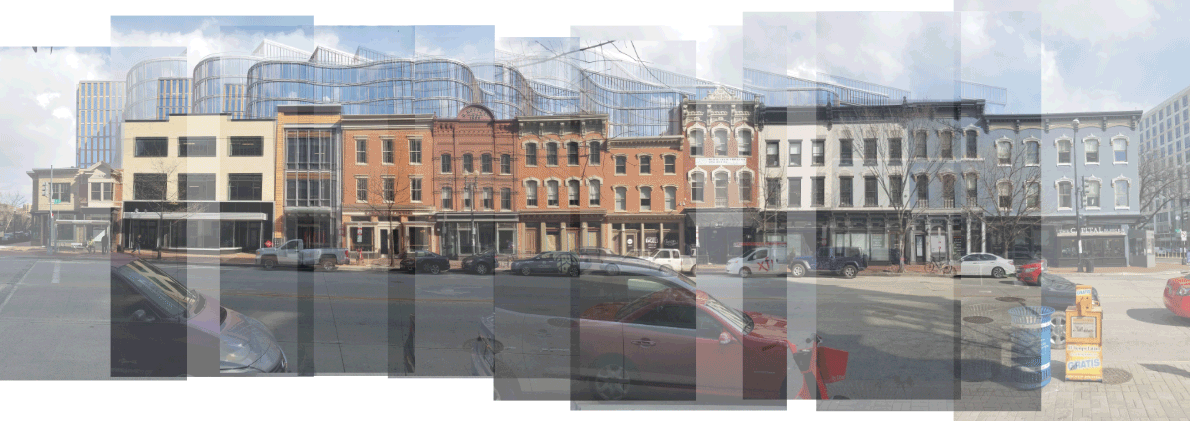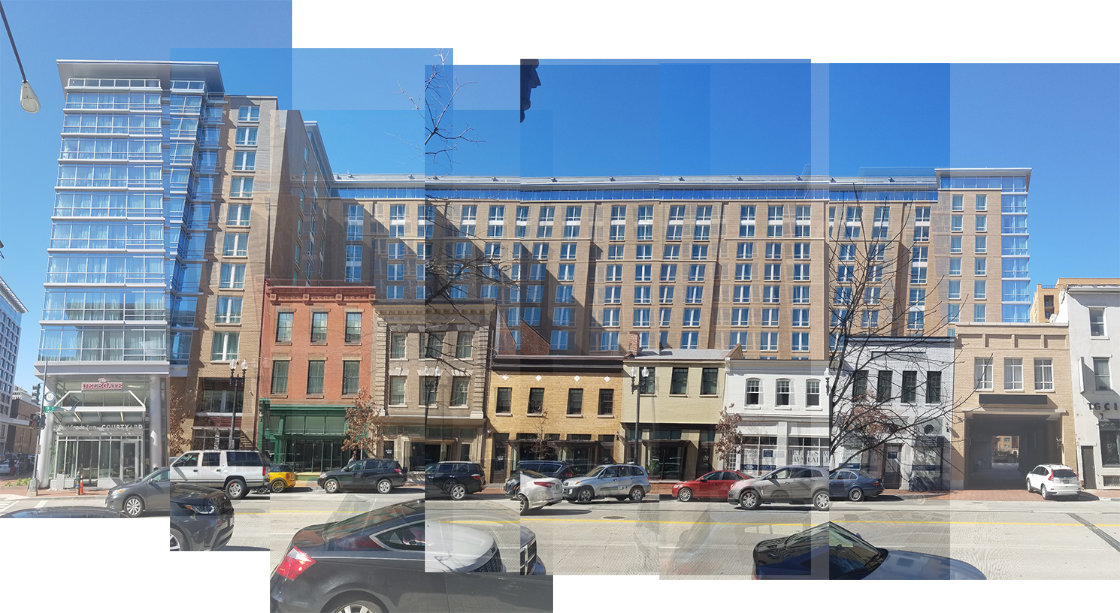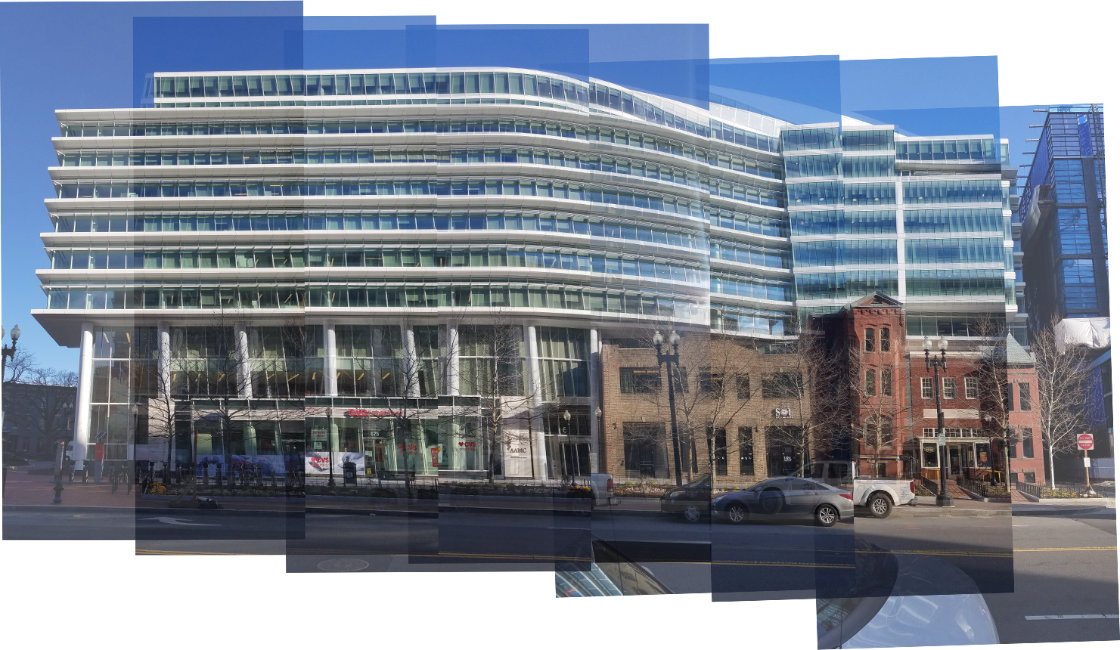

The Walter E. Washington Convention Center opened in 2003 to serve as the premiere exposition venue in the nation's capital. The building takes up what once was almost six large city blocks: K–N Streets NW and 7th–9th Streets NW.A Its bigness provides space in which any number or interrelated things can occur, but in this commitment to an inner efficiency, the convention center neglects its context. When built, it razed blocks and a street, and now it stands in stark early-2000s chic against the neighbourhood around it. Though the city around has grown to account for it with time, the convention center comes from the ahistorical and international. In the words of Rem Koolhaas, "It exists; at most, it coexists. Its subtext is fuck context."1

Across the street from the Walter E. Washington Convention Center, new reconciliations develop: metastructures. To the convention center's east, 655 New York Avenue presents curving glass facades broken up with terracotta louvers.B The mixed-use megacomplex would give nothing beyond a cursory acknowledgment to its neighborhood (the color of the terracotta resembles the local brick?) were it not anchored by a podium of gutted historic buildings. The new construction inhabits a few empty lots and alleyways, but the building occupies the remainder of the block by retaining the existing structures. Two-story brick vernaculars become ensnared in a single entity. Despite the globalness and bigness of the building's presence, the metastructure maintains Main Street. It offers a mom-and-pop, local-scale experience — even if this masquerade dissipates upon closer inspection. Many of 655 New York's storefronts display leasing information; prior tenants shuttered before the building came together. The remainder are filled with almost aggressively local enterprises: multiple restaurants either by local celebrity chefs or with a location-specific word like 'capital' in their name, a boutique bagel shop and a Compass Coffee (DC's local Starbucks). Beyond its gentrifying storefronts, the metastructure rises in glassy towers that offer the offices of anywhere — and as it turns out, WeWork has space in the building. The metastructure does not solve the effects of global capital. Its aesthetics disguise them, repackage them, and introduce them in a new form that keeps a connection with its environment. It mediates between the global present and the local history. It is a new form of contemporary ideological situations, be they capitalism, conservatism,2 globalism or otherwise. The metastructure is still big; it can accomodate any argument.

To the convention center's west, Columbia Place houses a Marriott hotel in a slightly sterner wrapping.C While the appearance of the tower may fit in amongst the neighborhood more than curved glass, its scale and program make clear that its priorities remain at a much larger scale. Again, to appease the discrepancy, the building retains the existing vernacular. Here, however, the assortment of shops that once made the streetfront have amalgamated into a single Franken-space. The Delegate, a hotel lobby bar and restaurant, spans five otherwise independent facades. The metastructure need not keep the divisions of the past; it only requires a rehabilitated base with which it can confront the street as an old friend. Unlike similar earlier juxtapositions (e.g. Norman Foster's Hearst Tower) that complement an existing architecture, metastructures create their base from previously disparate buildings. They turn urban fabric into an architecture. Accepting that their non-local core cannot adapt perfectly to the specific conditions of a site, metastructures attach directly to the architectures that define what a specific locale even is. Metastructures are parasitic. Through a coöptation of the vernacular, the global finds a way forward in a world at odds with itself.

The universalizing aesthetic of the Walter E. Washington Convention Center came into common understanding around 1932. That year, Philip Johnson and Henry-Russell Hitchcock curated the various hangovers of 19th-century eclecticism into a presentable package: the International Style. While not everyone would get on board with its criminalization of ornament, this pseudo-industrial aesthetic came into focus, and people learned how to find delight in it. Even then, locals bemoaned the loss of a particular vernacular in favor of an international style. In an attempt to mitigate the disparity between Modernism and local identities, critical regionalist architecture emerged.3 Alas, its bespoke approach could not by nature scale, so multinational developments continued propagating faceless, placeless boxes. Finally, the semiological lessons of Postmodern architecture transitioned the international to the global.4 In the global style, critical regionalist expressions became apparati that grounded otherwise universal architectures. The multinational entity found a way to adapt, but the global aesthetic never replicated the authentic localities lost. It only imitated, so the constant complaints of the neighborhood kept on. Today, architecture finds itself at the next crossroads between globalizing/modern and localizing/traditional forces. Rather than ignore, confront or appropriate, metastructures mediate.D

# Date [Return to] Title
500+ Ongoing Essays
550 May 2023 Platform Gamification
504 December 2022 On the Grid
518 December 2022 A Suspended Moment
A–Z Ongoing Glossary
G September 2022 – as in Girder
F May 2022 – as in Formal
* April 2022 – Key
E February 2022 – as in Entablature
D November 2021 – as in Duck
C August 2021 – as in Czarchitect
B June 2021 – as in Balustrade
A April 2021 – as in Aalto
0–15 December 2020 Journal
15 November 2020 Practice (in Theory)
14 October 2020 Alternative Narratives beyond Angkor
13 September 2020 Urban Preservation in Cuba
12e August 2020 Conversation on Copley Square: Summations
12d July 2020 Conversation on Copley Square: Conceptions
12c June 2020 Conversation on Copley Square: Reflections
12b June 2020 Conversation on Copley Square: Nonfictions
12a May 2020 Conversation on Copley Square: Foundations
11 May 2020 Out of OFFICE
10 March 2020 Hudson Yards from the High Line
9 March 2020 Metastructures
8 February 2020 Form, Program and Movements
7 February 2020 Life in the Ruins of Ruins
6 January 2020 The Urban Improvise
5 January 2020 Having Learned from Las Vegas, or Moving past Macau
4 December 2019 A Retrospective on the Decade's Spaces
3 December 2019 The Captive Global City
2 November 2019 Temporal Layers in Archaeological Space
1 November 2019 Contemporary Art Museums as Sculptures in the Field
0 Undated Manifesto: A Loose Architecture
© 2019 – 2023 Win Overholser
Comments
Loading comments...
Powered by HTML Comment Box.